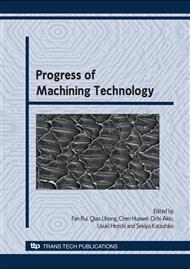p.636
p.640
p.644
p.649
p.654
p.658
p.662
p.667
p.672
Study on Cavitation Aided Abrasive Machining on Glass
Abstract:
The purpose of this study is to develop the cavitation aided abrasive machining which makes effective use of cavitation occurring in suction flow of slurry for fine machining. In this paper, a fundamental machining phenomenon of glass using the cavitation suction flow is clarified and machining characteristics are experimentally investigated by the observation of machined surface and surface roughness, stock removal and cavitation impact. Abrasive grains impinge on a workpiece surface to physically remove work material and generate fine surface in the machining. Then it can finish the polished glass surface of 9.3nmRz down to about 5.0nmRz by using abrasives of WA 4000.
Info:
Periodical:
Pages:
654-657
Citation:
Online since:
February 2009
Authors:
Price:
Сopyright:
© 2009 Trans Tech Publications Ltd. All Rights Reserved
Share:
Citation:


